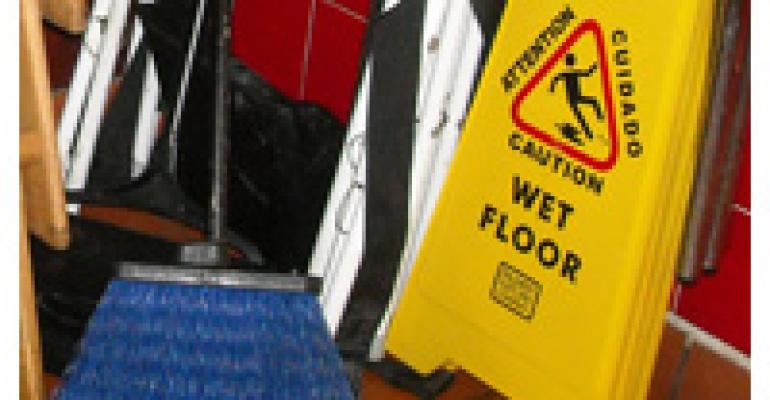
We hope your customer traffic has remained strong despite the barrage of powerful storms that have wracked most of the country this winter. But be careful: The moisture, salt, grit and other debris guests track in can really do a number on your floors. We’ve got five tips that will help you limit the damage and keep your restaurant looking shipshape.
“From ice melt to gravel, patrons track several different types of soil into a restaurant,” says Brian Garry, senior director of foodservice for Cincinnati, OH-based service provider Cintas. “This can result in unsightly residue lines, scratches to floor finish and other issues that shorten the life of the floor. By taking steps to protect, maintain and deep clean floor surfaces, restaurants can limit permanent damage and keep floors looking good throughout the winter.”
Here’s what Garry suggests restaurant owners do.
1. Roll out the mats. Stop dirt and debris from entering the building at the door. With a dual floor mat system in place, a rubber scraper mat outside your facility effectively removes soil from the shoe surface, while carpet mats in the entryway capture any residual dirt or soil.
During winter, a restaurant should also increase the number of mats used. Place mats in high traffic areas, such as in the walkway from the kitchen to front of house, throughout corridors leading to restrooms and in front of the order counter or bar. This will help reduce wear patterns, limit the potential for slips and falls and prevent puddles of water from forming.
Professionally laundered mats will increase the effectiveness of the program. Vacuuming only removes 10 percent of dirt from a mat, so ongoing mat maintenance is just as important as the placement of the mats.
2. Dedicate a staff member to frequent mopping. Assign one staff member each shift to the task of regularly wet mopping entryway areas and other floor surfaces throughout the restaurant. This can help reduce the accumulation of water and remove salt lines from ice melt. Determine cleaning frequency by traffic flow and weather severity. For example, heavy snow will likely result in increased water accumulation, so floors should be mopped more often during this period.
3. Regularly refresh cleaning tools. As floors become dirtier, so will the cleaning tools. To keep floors looking their best during the winter, change out the solutions in mop buckets and rinse and launder mop heads more frequently.
The type of cleaning chemicals used will also have an impact on the soil removal and efficacy of the floor care program. Make sure chemicals will effectively remove salt residue while also cleaning the floor surface.
4. Schedule a deep cleaning. In the summer months, deep cleaning restaurant floors may be required less often due to the limited buildup of soil on floor surfaces and between grout lines. However, in the winter it is very important to increase deep cleaning frequency to prevent harmful substances from corroding hard floor surfaces or discoloring carpet surfaces. According to ISSA—the World Cleaning Industry Association, one square yard of commercial carpeting captures one pound of dirt per week. That amount doubles in inclement weather. By effectively flushing out dirt and debris tracked into the facility, restaurants can substantially improve the appearance of floors with a regular deep cleaning program.
5. Conduct staff training. To keep staff aware of potential floor care issues, make sure each staff member is properly trained and understands the correct processes for cleaning floors. In addition to providing education on the proper technique, it is equally important to educate staff as to why keeping floors clean in the winter is important. If necessary, engage assistance with incentive programs. This increases the opportunity for full participation.
Think this is all much ado about nothing? Restaurant owners and managers who need a further reason to focus on their floor care programs this winter should be aware of a recent finding by the Harris Poll. The survey firm performed a study in which 68 percent of respondents indicated they would not return to a restaurant that had dirty floors. Would you?





